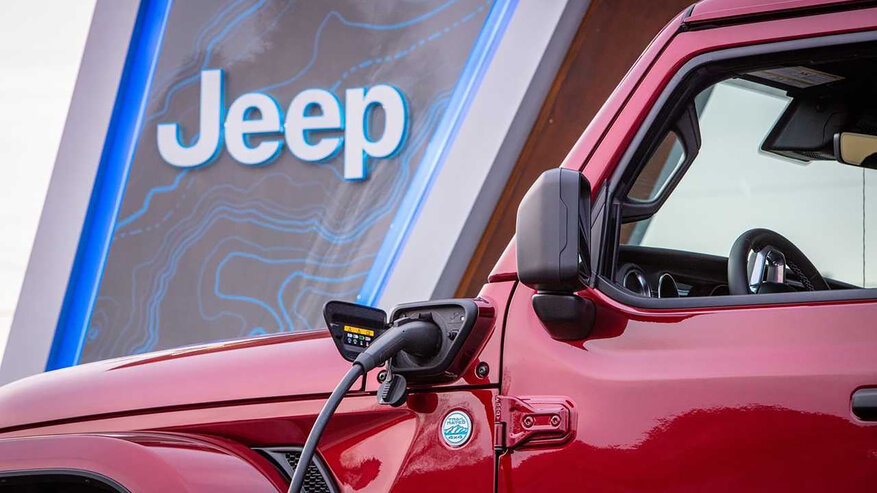by Josh Wayman
Torque Staff Writer
After three years of carting an all-electric Wrangler concept to Moab, Utah for Easter Jeep Safari, it now appears everyone could soon have a chance to purchase their own production Wrangler Battery Powered Vehicle in the near future.
Jeep CEO Christian Meunier recently announced the brand plans to launch a Wrangler BEV as early as the 2027 model year, while apparently still keeping its popular 4xe and gasoline-powered versions around as well for an all-inclusive vehicle lineup.
“Driven by the success of our electrified 4xe portfolio in North America and Europe, we are designing and developing the most capable and sustainable Jeep SUVs to date, on our path to becoming the leading zero-emission SUV brand in the world,” Meunier said. “This is a forward-thinking strategy to help ensure millions of Jeep fans around the world continue to have a planet to explore, embrace and protect. Electrification is great for our brand, making it even more capable, exciting, sustainable and fun.”
While Meunier did not indicate any tangible specifications for this all-electric Wrangler, its latest EJS electric concept, dubbed Magneto 3.0, did push out a stunning 900 lb-ft of torque and 650 horsepower this year in Moab. In comparison, the current production 4xe hybrid Wrangler offers 470 lb-ft of torque and 375 horsepower.
It is unlikely a production BEV Wrangler would receive that same level of Magneto power, but it could end up somewhere around the 4xe range, or the Wrangler 392’s 470 horses and lb-ft of torque. Additionally, besides eliminating that thirsty internal combustion engine, a huge benefit of an all-electric motor is instant torque and reliable power, so off-roading implications could be enormous.
However, battery life and effectively charging the vehicle in a reasonable time could be two potential hurdles the brand would need to overcome. Most BEV vehicles currently average somewhere between 250-300 miles on a full charge, but factors like weather and driving speed can affect that overall number. Additionally, charging time can significantly vary depending on the mechanism. For example, a level one home charger may take upwards of 14-15 hours to fully recharge a battery from lower percentages. A level two charger is normally 10 times as fast, but is a more expensive option. Public chargers, usually level three direct current versions, are the fastest around, yet may not be easily available when needed.
However, with EV tech growing by the year, those issues may not be as daunting when the vehicle is released.
For Jeep, Meunier offered its Trail Rating scale to lend perspective on the possible performance improvements of an all-electric Wrangler. This scale is built around five key principles: traction, water fording, maneuverability, wheel articulation and ground clearance.
“The Trail Rating is a scale up to 10,” he said. “At 10 is the two-door Wrangler Rubicon [and] the four-door Wrangler Rubicon is at nine. I want to push that to 12 (with a BEV Wrangler).”
Meunier also offered potential design thoughts including possibly swapping from solid axles to an independent suspension.
“The architecture around it, the suspension system, the axle you’re going to use, can be anything – a solid axle or independent suspension.” he said. “Electrification doesn’t prevent us from doing anything when it comes to off-roading. It enhances our capability because you have more torque, better control and smoother power delivery.”
Jeep’s current 4xe hybrid has proven extremely popular and is currently the top-selling PHEV in North America, according to Jeep.
“In quarter one, 38% of all Wranglers we sold were [electrified] 4xe models,” Meunuier said. “And by the end of this year, I bet it’s going to be more like 50 or 60%. That’s not because people are forced; when they test drive it, they understand they can drive 20 to 25 miles on electric power and go to the gas station less.”
Before a BEV Wrangler hits the US, Jeep does plan for another fully-electric vehicle to enter the market sometime in 2024— the Renegade-styled Recon EV.
It debuted earlier this year with removable doors and squared off-fenders, as well as a retractable powertop roof and removable rear side glass windows. Additionally, Jeep said the vehicle will feature a Selec-Terrain traction system, lockable axles, underbody skid plate protection, tow hook recovery points and beefy off-road tires.
Jeep did not reveal performance expectations like mileage per charge or horsepower, but said it does expect Wrangler-like on- and off-road ability.
“The all-new, all-electric Jeep Recon has the capability to cross the mighty Rubicon Trail, one of the most challenging off-road trails in the U.S., and reach the end of the trail with enough range to drive back to town and recharge,” Meunier said.





















